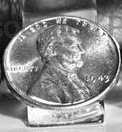Command coin of the chairman, Joint Chiefs of Staff
Replace the Pentagon brass? Don’t even zinc of it!
Sometimes it’s the smallest things that make the biggest statement. Take the latest solicitation, here, seeking to strike up to 38,000 brass coins – so-called “command coins” freely given out by the nation’s top military leaders to troops and others. They cost an estimated $5 each. Small potatoes in the overall scheme of things.
But a possible bidder had an interesting question, here, about the coins, soon to be struck for Army General Martin Dempsey, chairman of the Joint Chiefs of Staff, Navy Admiral James Winnefeld, Jr., the vice chairman, and Marine Corps Sgt. Maj. Bryan Battaglia, senior enlisted adviser to the chairman of the Joint Chiefs:
Question: “Can a zinc alloy substitute for brass to keep cost down?”
Answer: “The coin specification is brass.”
Let’s face it – the coins are nice and big and heavy (nearly two ounces each!), and make for a wonderful memento when the brass visits.
“The Protocol Office for the Chairman of the Joint Chief of Staff has the responsibility for providing coins for the Chairman of the Joint Chiefs of Staff (CJCS), Vice Chairman of the Joint Chiefs of Staff (VCJCS) and the Senior Enlisted Advisor to the Chairman of the Joint Chiefs of Staff (SEAC),” the solicitation says. “This contract action is for the production and delivery of coins for the CJCS, VCJCS and SEAC to allow the senior leadership to provide official courtesies and recognition to Foreign Nationals and Department of Defense employees.”
Here are the specs for the chairman’s dogtag-shaped coin:
It is 2.25 inches long by 3.5 mm thick die struck brass satin bronze antique color dog tag coin with a hole at the side. Approximate weight ~ 48 grams. It has the 18th Chairman Joint Chiefs of Staff white and blue flag on one side four stars (two white and two blue), gold eagle with shield and three arrows. It also has the 18th Chairman Joint Chiefs of Staff wording in bronze within the black enamel border; and Presented by General Martin E. Dempsey on the reverse side in bronze within the black enamel border; it contains six seals representing each branch of service’s logo and the Joint Chiefs of Staff logo (United States Army, United States Marine Corps, United States Navy, United States Air Force and the United States Coast Guard).
“Zinc is cheaper and lighter than brass, and therefore lowers your overall cost,” says Chris Dougherty of Greek Challenge Coins LLC of Clarkston, Mich., one of the companies interested in the contract. The unalloyed truth: basic brass is two parts copper to one part zinc, and copper, at about $3.50 a pound, costs about four times as much as zinc. “A zinc coin,” Dougherty says, “would be much cheaper than a brass coin.” Zinc is also 20% lighter than copper.
Dougherty says he is happy the military nixed the move to zinc. “Challenge coins aren’t simply meaningless tokens,” he says. “They are symbolic representations that have meaning…especially to the military!”
True enough. When you travel with senior military leaders, there’s always some guy with a rucksack full of such coins, ready to hand them wholesale to the boss, so he can hand them out, retail, to the troops. And the troops, make no mistake about it, love getting them. (Coin history, here.)
But heck, the Pentagon has been trying to get lighter for decades – in its aircraft, its armor, and its troops. Why not make the best out of a bad situation, and strike the command coins out of a zinc alloy for a while? After all, Dempsey said Monday he is looking everywhere “to sweep up every bit of money we can find in the next six months.”
Dempsey himself could make a video – like General Jim Amos, the Marine commandant did the other day, here – and say something like this to the troops:
I’m always pleased to visit you at home and overseas, and leave you with a command coin as a small token of my appreciation for your hard work, bravery, and your family’s sacrifice. But when I pass out coins later, you may notice they’re a little lighter than ones you might have gotten in the past. That’s because we had to strike them out of zinc instead of brass, to save money. They’re special coins – they won’t be around forever — but they mark a time when you and I served together, and grappled with the fiscal challenges facing our great nation.
For those of you old enough to remember, it’s kind of like the zinc-coated steel pennies that the nation minted in 1943 at the height of World War II. We needed the copper — for shell casings — so we ended up with zinc-clad pennies for a while. In the same way, my command coin will be lighter for the foreseeable future, to reflect the cuts the nation, and the nation’s military, have to make from the bottom to the top. And what better place for the U.S. military to begin – to set an example – than at the top?
Hey. You have to start somewhere…



